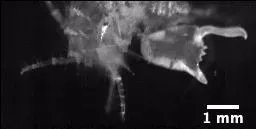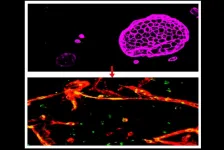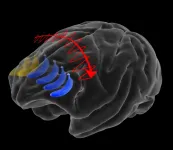(Press-News.org) DURHAM, N.C. -- The world's most technologically advanced robots would lose in a competition with a tiny crustacean.
Just the size of a sunflower seed, the amphipod Dulichiella cf. appendiculata has been found by Duke researchers to snap its giant claw shut 10,000 times faster than the blink of a human eye.
The claw, which only occurs on one side in males, is impressive, reaching 30% of an adult's body mass. Its ultrafast closing makes an audible snap, creating water jets and sometimes producing small bubbles due to rapid changes in water pressure, a phenomenon known as cavitation.
Three things make this ultra-fast movement unique said Sarah Longo, who studied the amphipods as part of her postdoctoral studies at Duke: the amphipods' really small size, the fact that they live in water, and the repeatability of their movements.
Other animals have comparable accelerations, but none has the same set of constraints: the jaws of trap-jaw ants are faster, but move through air. Mantis shrimp are comparably fast and aquatic, but much larger. Jellyfish stinging cells are ejected with higher acceleration, but only once.
"We take repeatability for granted in biology," said Longo, a visiting assistant professor at Towson University and first author on the paper. "Lots of ultrafast movements are not repeatable, such as ballistic seed ejection by plants. Some of these seeds are going even faster than this amphipod and traveling an impressive distance, but they are one-off events."
Repeatability is a big challenge for engineering, said Longo. Parts that move very fast often become disconnected, break, or have to be manually reloaded.
"The fact that this movement is repeatable is marking an interesting boundary," Longo said. "There appears to be a cutoff where you are going so fast that you inherently have to give up repeatability. These animals are showing how fast you can actually go without breaking."
"These organisms are doing things with capabilities that we currently cannot build. Engineered systems that can be used repeatedly are several orders of magnitude slower and bigger than these animals," said Sheila Patek, a professor at Duke Biology and senior author on the paper.
The potential behind ultrafast movements is so great that the Army is paying attention to these small animals.
"Small organisms achieve incredible actuation authority with no adherence to the rules we use for engineering using motors, springs, and structures," said Samuel Stanton, program manager, Army Research Office, an element of the U.S. Army Combat Capabilities Development Command's Army Research Laboratory. "There is a myriad of organisms from which we can learn a great deal for future Army small robotics and this research team is discovering a whole new set of rules we should be following."
"There is a lot that biology can tell us," Longo said. "Evolution has had millions of years to come up with solutions to all sorts of problems that we can't even articulate yet."
This discovery is surprising given that these amphipods are very common, being found all over the Eastern coast of North America.
"The majority of biologists tend not to pay much attention to amphipods, because they are so small," said Rich Palmer, a professor at the University of Alberta and co-author on the paper. "We would never have guessed that they make these ultra fast movements."
Palmer had his attention drawn to these animals when colleagues mentioned in a casual conservation that certain amphipods made snapping noises.
Intrigued, he suggested to Patek a trip to the Duke Marine Laboratory, in Beaufort, NC, in order to investigate these snaps further. To everyone's surprise and delight, they found thousands of these ultra fast animals right off the docks.
"Hanging in debris, off a dock, in some junky algae, are creatures whose capabilities we didn't even know existed," says Patek. "This is what happens if you take a second look at a weird animal and just take the time to figure out what they are doing."
"You have to be curious, you have to be brave, and you can't be afraid of wasting time," said Palmer. "That is how amazing discoveries are made."
INFORMATION:
This work was supported by the U.S. Army Research Laboratory and the U.S. Army Research Office under contract/grant number W911NF-15-1-0358 and NSERC Canada Discovery Grants RGPIN 04863 and RGPAS 462299.
CITATION: "Snaps of a Tiny Amphipod Push The Boundary of Ultrafast, Repeatable Movement" Longo, S. J., Ray, W. Farley, G. M. Harrison, J., Jorge, J., Kaji, T. Palmer, A. R., Patek, S. N. Current Biology, Feb. 8, 2021. DOI: 10.1016/j.cub.2020.12.025
Bark beetle outbreaks and wildfire alone are not a death sentence for Colorado's beloved forests--but when combined, their toll may become more permanent, shows new research from the University of Colorado Boulder.
It finds that when wildfire follows a severe spruce beetle outbreak in the Rocky Mountains, Engelmann spruce trees are unable to recover and grow back, while aspen tree roots survive underground. The study, published last month in Ecosphere, is one of the first to document the effects of bark beetle kill on high elevation forests' recovery from wildfire.
"The fact that Aspen is regenerating prolifically after wildfire is not a surprise," said Robert Andrus, who conducted ...
A team of engineers and scientists has developed a method of 'multiplying' organoids: miniature collections of cells that mimic the behaviour of various organs and are promising tools for the study of human biology and disease.
The researchers, from the University of Cambridge, used their method to culture and grow a 'mini-airway', the first time that a tube-shaped organoid has been developed without the need for any external support.
Using a mould made of a specialised polymer, the researchers were able to guide the size and shape of the mini-airway, grown from adult mouse stem cells, and then remove it from the mould when it reached ...
DANVILLE, Pa. - Researchers at Geisinger have found that a computer algorithm developed using echocardiogram videos of the heart can predict mortality within a year.
The algorithm--an example of what is known as machine learning, or artificial intelligence (AI)--outperformed other clinically used predictors, including pooled cohort equations and the Seattle Heart Failure score. The results of the study were published in Nature Biomedical Engineering.
"We were excited to find that machine learning can leverage unstructured datasets such as medical images and videos to improve on a wide range of clinical prediction models," said Chris Haggerty, Ph.D., co-senior author and assistant ...
A type of cell derived from human stem cells that has been widely used for brain research and drug development may have been leading researchers astray for years, according to a study from scientists at Weill Cornell Medicine and Columbia University Irving Medical Center.
The cell, known as an induced Brain Microvascular Endothelial Cell (iBMEC), was first described by other researchers in 2012, and has been used to model the special lining of capillaries in the brain that is called the "blood-brain barrier." Many brain diseases, including brain cancers as well as degenerative ...
Older adults who are classified as having "prediabetes" due to moderately elevated measures of blood sugar usually don't go on to develop full-blown diabetes, according to a study led by researchers at Johns Hopkins Bloomberg School of Public Health.
Doctors still consider prediabetes a useful indicator of future diabetes risk in young and middle-aged adults. However, the study, which followed nearly 3,500 older adults, of median age 76, for about six and a half years, suggests that prediabetes is not a useful marker of diabetes risk in people of more advanced age.
The results were published February 8 in JAMA ...
Ask anyone from an NFL quarterback scanning the field for open receivers, to an air traffic controller monitoring the positions of planes, to a mom watching her kids run around at the park: We depend on our brain to hold what we see in mind, even as we shift our gaze around and even temporarily look away. This capability of "visual working memory" feels effortless, but a new MIT study shows that the brain works hard to keep up. Whenever a key object shifts across our field of view--either because it moved or our eyes did--the brain immediately transfers a memory of it by re-encoding it among neurons in the opposite brain hemisphere.
The finding, published in Neuron by neuroscientists at The Picower Institute for Learning and Memory, explains via experiments in animals how we can keep ...
The snapping claws of male amphipods--tiny, shrimplike crustaceans--are among the fastest and most energetic of any life on Earth. Researchers reporting in the journal Current Biology on February 8 find that the crustaceans can repeatedly close their claws in less than 0.01% of a second, generating high-energy water jets and audible pops. The snapping claws are so fast, they almost defy the laws of physics.
"What's really amazing about these amphipods is that they're sitting right on the boundary of what we think is possible in terms of how small something can be and how fast it can move without self-destructing," says senior author Sheila Patek, a Professor of Biology at Duke University. "If they accelerated any faster, their bodies would break."
While amphipods are ...
What The Study Did: The National Health Service in Italy provides universal coverage to citizens but because no approved drug was available for COVID-19, patients received potentially effective drugs, participated in clinical trials, accessed compassionate drug use programs or self-medicated. This study evaluated changes in drug demand during the early phase of the COVID-19 outbreak in Italy compared with the period before the outbreak.
Authors: Adriana Ammassari, M.D., of the Italian Medicines Agency in Rome, is the corresponding author.
To access the embargoed study: Visit our For The Media website at this link https://media.jamanetwork.com/
(doi:10.1001/jamanetworkopen.2020.37060)
Editor's ...
Philadelphia, February 8, 2021--Adding to a growing body of research affirming the benefits of fetal surgery for spina bifida, new findings show prenatal repair of the spinal column confers physical gains that extend into childhood. The researchers found that children who had undergone fetal surgery for myelomeningocele, the most severe form of spina bifida, were more likely than those who received postnatal repair to walk independently, go up and down stairs, and perform self-care tasks like using a fork, washing hands and brushing teeth. They also had stronger leg muscles and walked faster than children who had their spina bifida surgery ...
What The Study Did: This observational study compared different measures of prediabetes and the risk of progression to diabetes among adults age 71 to 90.
Authors: Mary R. Rooney, Ph.D., M.P.H., of the Johns Hopkins Bloomberg School of Public Health in Baltimore, is the corresponding author.
To access the embargoed study: Visit our For The Media website at this link https://media.jamanetwork.com/
(doi:10.1001/jamainternmed.2020.8774)
Editor's Note: The article includes conflicts of interest and funding/support disclosures. Please see the article for additional information, including other authors, author contributions and ...




